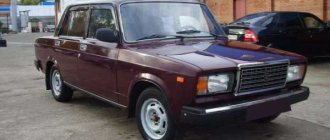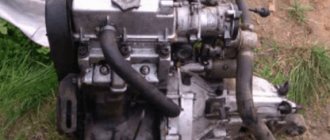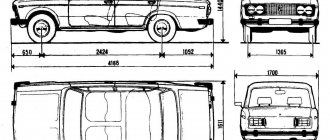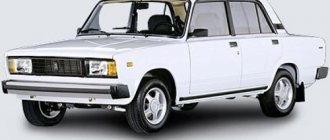The VAZ 2107 is a rear-wheel drive sedan produced at the Volzhsky Automobile Plant since 1982. The improved design at one time awarded the car the title of “Russian Mercedes”. At its core, the Lada VAZ 2107 is a luxury version of the utilitarian small car VAZ 2105. This is noticeable at first glance thanks to a different solution for the front part of the hood with stamping for a metal chrome radiator grille, and new rear block lights. The interior is equipped with a glare-free panel with a tachometer and additional sensors, anatomical seats, and increased passive safety, but the only downside is the lack of anti-corrosion coating on the body.
The technical characteristics of the VAZ 2107 depend on four-cylinder carburetor engines, which are equipped with a four-speed or five-speed gearbox. In 1992, the five-speed gearbox for the VAZ 21074 was modernized, which made servicing the VAZ 2107 economical. Now the VAZ 2107 is equipped only with gasoline engines with electronic fuel injection.
Bringing the car to the world market, the designers equipped the car with a 1.7 liter engine with a power of 84 horsepower, which meets environmental protection requirements. For the Asian market, they released a 1.45 liter car with 66 horsepower, which was “powered” by gasoline with an octane rating of 76.
Later versions of the car are equipped with a 1.6-liter engine that complies with European gas emission standards - EURO-3.
The last Zhiguli car (in the classic rear-wheel drive version) was the VAZ-21074. The technical characteristics of this car allowed the model to become one of the most popular among car enthusiasts in the USSR.
Main characteristics of the model
In the large model range of Zhiguli cars, the VAZ-21074 stands apart. A powerful engine with a displacement of 1569 cm 3 gave it the right at that time to be considered the fastest rear-wheel drive sedan that rolled off the assembly line of the Volzhsky Automobile Plant.
On the first models of the 7th series, the engine was similar to the 5th model. Only a little later they began to install a more powerful engine from the no less popular VAZ-2106 car.
The vehicle's ground clearance is 17.5 cm. The installed tires have an outer radius of 165 mm. The volume of the luggage compartment is 355 liters. The total curb weight of the vehicle is 1430 kg. Maximum speed is 150 km/h. In 16 seconds the car accelerates to hundreds. A fuel tank of 39 liters allows you to store a fuel reserve of 400 km in urban mode.
The brake system did not change and was inherited from the prototype model - VAZ 2105. Initially, these cars were almost identical, but, nevertheless, they had certain distinctive features, namely:
- shape of the hood and trunk;
- radiator screen;
- rear lights;
- chrome bumper trims.
The car has proven itself to be unpretentious in operation, and the cost of spare parts is in an affordable price segment. This aspect is one of the main factors that positively influences the buyer’s choice (in favor of the VAZ-21074). We will consider the technical characteristics of components and assemblies in more detail below.
Salon
Among all the classic Zhiguli models, the interior of the VAZ-21074 is the most comfortable and modern. The front seats compare favorably with their predecessors - sitting in them is much more comfortable. Anatomical seats without headrests are a distinctive feature of the “Seven”.
Improved interior trim with higher quality materials and modern seat upholstery have allowed the VAZ-21074 to occupy a leading position in the domestic car market for many years.
In general, the VAZ-21074, the technical characteristics of which were disclosed in this article, deserves respect and trust from car enthusiasts. The affordable cost of both the car and spare parts was appreciated by consumers. This is confirmed by the popularity of the car, which continues to this day.
Engine and transmission
The engine from the VAZ-2106 was installed on the VAZ-21074 model without any modifications. The technical characteristics of the engine made it possible to achieve a power of 74 hp. With. There are 2 valves per cylinder. The “five” had a belt drive of the camshaft, which made the engine less noisy. However, a belt is less reliable than a chain. Therefore, on a more powerful engine, it was decided to leave the timing chain transmission unchanged.
The gearbox compares favorably with its predecessors. It has a fifth speed, the gear ratio of which is 0.819. All other speeds have lower gear ratios compared to previous analogues. As a result, the gearbox operates more “softly”. The rear axle gearbox with self-locking differentials has 22 splines - it was borrowed from the VAZ-2106 model.
The suspension of the front pair of wheels is independent. The rear suspension has a rigid beam. This design significantly improved the car's stability when cornering.
VAZ 21074 carburetor - model review
The “seventh” series of VAZ left the factory assembly line in 1982. The “Seven” was a “luxury” version of the previous VAZ 2105 model, which, in turn, was developed on the basis of the Fiat 124. That is, we can say that the roots of the domestic automotive industry go back to the Italian auto industry.
In the spring of 2022, the analytical agency Autostat found that the most popular sedan in Russia is the VAZ 2107 and all its modifications. At the time of the study, more than 1.75 million Russians used a car.
One of the most popular AvtoVAZ models is 21074
Where are the body number and engine number located?
Any car produced at the Volzhsky Automobile Plant must receive several identification numbers. So, the most important of them are the body number and engine number.
The engine number is a kind of passport for a specific model, because you can use it to identify the car and trace the entire history of the “four” from the very beginning. The engine number on the VAZ 21074 is stamped on the left wall of the cylinder block, immediately under the distributor.
Data is stamped on metal using template numbers.
All other vehicle data sheets can be found on the aluminum plate located on the bottom shelf of the air intake box. The following parameters are selected here:
- model name;
- body number (individual for each VAZ);
- power unit model;
- information on vehicle weight;
- machine version (equipment);
- marking of main spare parts.
A plate with basic data on the car is attached to all VAZ models on the air supply box
Unfortunately, or maybe fortunately, this car has been discontinued and can only be purchased on the secondary market. There are no special packages. This car is quite popular for tuning; car owners understand that their cars are very far from ideal and make them either retro or racing style. My car was bought for 45,000 rubles for the same amount and was sold. But no matter what it was, only positive memories remained in my memory
Pavel12
https://www.ssolovey.ru/pages/vaz_21074_otzyvy_vladelcev.html
Video: general overview of the car
Carburetor
The first cars in the series had a carburetor installed in the VAZ-21074. The technical characteristics of an engine with this type of fuel injection were as follows:
- fuel type - AI-95;
- engine power - 75 hp. With.;
- torque - 116 Nm (at 3750 rpm);
- fuel consumption (city) - 9.7 l/100 km;
- fuel consumption (highway) - 7.3 l/100 km;
- Acceleration time to 100 km/h - 15 seconds.
On the model with a vacuum corrector, a DAAZ 2107-1107010-20 carburetor was installed. Over the years of operation, this unit has proven its reliability and durability. Despite this, the carburetor system is very sensitive to fuel quality. Therefore, the manufacturer began installing a modern injection system on models of later years of production.
Total information
| Options | VAZ 2107 | VAZ 21074 | VAZ 2107-20 | VAZ 21074-20 |
| Weight of the equipped vehicle, kg | 1060 | 1060 | 1060 | 1060 |
| Payload, kg | 400 | 400 | 400 | 400 |
| Permitted maximum weight, kg | 1460 | 1460 | 1460 | 1460 |
| Ground clearance of a vehicle with a permissible maximum weight, with tires 175/70 R13, not less, mm: | ||||
| to the front suspension cross member | 162 | 162 | 162 | 159 |
| to the rear axle beam | 157 | 157 | 157 | 154 |
| Permissible weight of cargo on the additional (top) luggage rack, kg | 50 | 50 | 50 | 50 |
| Maximum speed, km/h: | ||||
| with permissible maximum weight | 148 | 148 | — | — |
| with driver and passenger | 150 | 150 | 150 | 150 |
| Acceleration time from standstill to 100 km/h, s: | ||||
| with driver and one passenger | 17 | 16 | 17 | 16 |
| with permissible maximum weight | 19 | 17,5 | — | — |
| Minimum turning radius along the track of the outer front wheel, m | 5,6 | 5,6 | 5,6 | 5,6 |
| The greatest rise overcome by a car with a permissible maximum weight without acceleration in first gear, % | 36 | 36 | 36 | 36 |
Injector
The first injection VAZ-21074 appeared only in 2006. Car enthusiasts were enthusiastic about the new product and preferred to buy cars with such an injection system.
Despite the fact that the cost of such a car was higher, the complexity of the equipment (the presence of a computer unit, a number of sensors) meant slightly higher operating costs, but at the same time a number of advantages appeared, namely:
- Lower fuel consumption compared to the carburetor model.
- Easy engine starting (especially in cold weather).
- The influence of fuel quality on the nature of engine operation was neutralized.
- Stable engine operation at idle speeds, which are much lower than those of carburetor models.
The installation of a modern injection system has opened up new opportunities for VAZ-21074 owners. The injector allows you to change the technical characteristics very quickly - reprogramming the control unit can make the engine more economical or, conversely, more powerful and responsive. There is no need to change the engine design in any way.
Description of the salon
By modern standards, the exterior of the VAZ 21074 is outdated.
It’s difficult to talk about the appearance, because in fact the car is very outdated and looks like a rarity in the city. But in any case, from a certain angle, we can say that it doesn’t seem to be scary. In a word, classicism.
Andreyka
https://www.avtodor.su/articles-avtomobil-vaz-21074
Due to the fact that the entire line of the VAZ 2107 family (and the VAZ 21074 is no exception here) is rear-wheel drive, the engine is located in front, which made it possible to significantly expand the interior space: both in the ceiling and in the legs for the driver and front row passenger.
Compared to previous versions of the VAZ, the 21074 is more spacious inside
The interior trim is made of special plastic alloys that do not give glare and are easy to maintain. The floor of the car is covered with polypropylene mats. The body pillars and the inner parts of the doors are covered with medium-hard plastic and covered with caprovelor on top. The seats in most cars are upholstered in durable, wear-resistant fabric - velutine.
It must also be said that the VAZ 21074 uses a large number of “auxiliary” materials for interior decoration - various types of mastics, bitumen gaskets, felt pads and lines. All these materials come into contact with the upholstery in one way or another (doors, bottom, seats) and protect the interior from excessive noise from the outside. Bitumen and mastic are used primarily in vehicle underbody equipment, while soft and textile materials are used in upholstery and trim. This equipment not only helps make a person’s stay in the cabin more comfortable, but also solves a number of other problems:
- increased cabin sound insulation;
- minimizing vibration waves while driving;
- protection of metal from rust;
- increasing the thermal insulation of the cabin.
High-quality plastic and durable velutine fabric are used to equip the interior.
Dashboard
VAZ 21074 is considered a more comfortable version of the VAZ 2107. Comfort is achieved in various ways, including making it easier to drive. Thus, the instrument panel allows the driver to see current data on both the ride and the condition of his “iron horse” at any time.
On the VAZ 21074, the dashboard is made up of many elements, each of which shows the operation of a particular unit in the car. The panel is embedded in the dashboard of the car on the driver's side. All elements are located under plastic glass: on the one hand, they are clearly visible, on the other, the devices will be protected from possible mechanical shocks.
The instrument panel is protected from external influences by a plastic visor and durable glass
The instrument panel of the VAZ 21074 contains the following elements:
- A speedometer is a special mechanism that shows the current speed. The scale is numbered in divisions from 0 to 180, where each division is the speed in kilometers per hour.
- Tachometer - located to the left of the speedometer and is used so that the driver can see the crankshaft rotation speed per minute.
- ECON fuel consumption gauge.
- Engine temperature indicator - for the VAZ 21074, the engine operating temperature is set in the range of 91–95 degrees. If the pointer needle “crawls” into the red zone of the device, the power unit is working at the limit of its capabilities.
- Fuel quantity indicator in the gas tank.
- Accumulator charging. If the battery light comes on, it is necessary to provide additional charging to the battery (the battery is discharged).
In addition, there are additional lights and indicators on the instrument panel that remain turned off during normal operation (for example, engine oil level, engine problems, high beam, etc.). The lights turn on only when there is a problem with a particular system or when a certain option is enabled.
Illuminated additional elements indicate errors, problems or the inclusion of an option
Gear shift diagram
The gearbox on the VAZ 21074 operates according to the international standard. That is, the first four gears are switched on by analogy with the writing of the Russian letter “I”: up, down, up, down, and the fifth - to the right and forward. Reverse speed is switched to the right and backward.
Video: universal speed shifting
Some questions among drivers are controversial. For example, when is it better to change gears in a car:
don’t pay attention to the rpm, look at the speed, the first one starts, the second one is up to 40, the third is at least up to 80 (the consumption will be high, better than 60), then the fourth, if the hill is ahead and you have 60 and the fourth, then it’s better to go to a lower speed select only when switching (at the moment the clutch pedal is released), so that it is smooth, without jerking, and in general the marks are already made on the speedometer) when you need to switch
Gear shifting on the VAZ 21074 is carried out in the same way as on modern cars according to the international standard for manual transmission
The VAZ 21074 car is still actively used by car enthusiasts today. Despite the outdated design and limited functionality (compared to modern standards), the machine is very reliable and durable. In addition, the simplicity of the design allows you to fix all breakdowns yourself and not spend money on expensive service services.
Modifications of VAZ 2107
It turns out that the seven had a lot of modifications, which sometimes even the workers of the plant in Tolyatti are not aware of. And we know and willingly share this information with fans of VAZ retro. The technical characteristics of the VAZ 21074 (shown in the table) are actually no different from other Ladas with a six-wheel engine, with the exception of some nuances that could not be noticed at all, but respecting the traditions of the plant, they are worth emphasizing.
So, the “pure” seven, 2107, came only with a four-speed manual transmission and a three-liter one and a half liter engine with a carburetor power system. But today we are not talking about it, but about its first modification, the seven with an engine from the VAZ 2106, which received the factory index 21074.
Vehicle specifications
The VAZ 21074 is made in a sedan body - both in the opinion of the plant’s designers and in the opinion of car enthusiasts, a sedan is the most convenient “box” for both personal use and for cargo transportation.
It is worth noting that the carrying capacity of the machine indicated in the technical documents (1430 kg) is underestimated. Surely you have more than once seen a “four” loaded to maximum, on which neighbors were transporting things or bags of potatoes. Until now, in any market, a fairly large number of sellers use the VAZ 21074 to transport goods. Do not forget that initially the model was not created for the transportation of goods in principle!
The carburetor mechanism in the VAZ 21074 is two-chamber, emulsion
How is 21074 different?
The main and, perhaps, the only difference from the beds of other sevens of various modifications is in the engine. This is a 1.6-liter (more precisely, 1,569 cc) engine with a cast-iron Fiat block and an aluminum head. Initially, the engine ran only on 93-octane gasoline, but later the compression ratio was lowered to allow the vehicle to be operated on lower grades of fuel. Since the power system still remained carburetor, there was not much difference. The seven happily consumed about 10 liters of fuel in mixed mode.
Seventy-five power and 116 Nm of torque look helpless by modern standards, but then for the country that built communism, it was proletarian chic. Even the Volga was more powerful by only a dozen forces. Toward the end of its career, 21074 still received distributed injection, although it was a different modification, 21074-10, which met Euro2 standards, and the next year an even more advanced seven 21074-20 with an injector appeared, which could meet Euro3 standards. But the injection versions of the six engine completely abandoned 92 gasoline and required only high-octane 95 gasoline.
Engines
| Options | VAZ 2103 | VAZ 2106 | VAZ 2104 | VAZ 21067 |
| Number and arrangement of cylinders | four-cylinder, four-stroke, in-line | |||
| Supply system | carburetor | distributed injection | ||
| Octane number of gasoline | 92-93 | 95 | ||
| Cylinder diameter and piston stroke, mm | 76×80 | 79×80 | 76×80 | 79×80 |
| Cylinder operating order | 1-3-4-2 | |||
| Compression ratio | 8,5 | 8,5 | 8,5 | 8,5 |
| Working volume, l | 1,45 | 1,57 | 1,45 | 1,57 |
| Rated power, according to GOST 14846 (net), kW (hp) | 52,5 (71,4) | 54,8 (74,5) | 50,0 (68,0) | 54,5 |
| Crankshaft rotation speed at rated power, min-1 | 5600 | 5600 | 5000 | 5000 |
| Maximum torque at crankshaft speed 3400 min-1 (3000 min-1 for VAZ 2106 engine), N*m | 103,9 | 116 | — | — |
| Minimum crankshaft rotation speed, min-1 | 850-900 | 850-900 | 820-880 | 820-880 |
| Direction of rotation of the crankshaft from the pulley side | right | |||
| Lubrication system | combined, pressure and spray | |||
| Cooling system | liquid, closed, forced circulation | |||
| Crankcase ventilation system | forced, with crankcase gases vented into the intake manifold | |||
Operational features and popular love
There is no particular need to talk about any dynamic characteristics of the VAZ 21074 with a classic carburetor. Stock sevens could accelerate to hundreds in 16 seconds. During this time, a Volkswagen Golf of the same year of production could accelerate to 200 km/h, and a mid-range sports car could enter Earth orbit, but that was not why the seven was valued. And they appreciate it now.
They loved it for its unpretentiousness in repairs, ease of maintenance, and for the fact that in every village store you could buy at least a ball joint, a head gasket, or a carburetor repair kit. Moreover, all the repairs could be done with your own, even not very skillful, hands, and a good breakdown of a reliable Fiat engine happened extremely rarely, and even then due to the driver’s oversight. The Seven with the 2106 engine was loved for its timing chain drive. The fact is that on the five-wheel engines that were installed on version 21072, the timing drive was belt driven, which meant that if the belt breaks, bending of the valves and failure of the cylinder head is guaranteed unless pistons with special “five-point” grooves are installed. The engine made less noise, but was 3 horses weaker.
Transmission
| Clutch | single-disk, dry, with hydraulic shutdown drive and central diaphragm spring | |||
| Transmission | mechanical, four- or five-speed, three-way, three-shaft, with synchronizers on all forward gears | |||
| Gear ratios: | ||||
| first | 3,67 | |||
| second | 2,10 | |||
| third | 1,36 | |||
| fourth | 1,0 | |||
| fifth | 0,82 | |||
| reverse | 3,53 | |||
| Cardan transmission | two-shaft, with intermediate support and elastic coupling | |||
| main gear | hypoid | |||
| Final drive ratio | gear ratio - 3.9 or 4.1 | |||
| Differential | conical, two-satellite | |||









